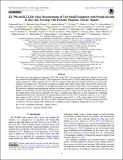K2-79b and K2-222b : mass measurements of two small exoplanets with periods beyond 10 days that overlap with periodic magnetic activity signals
Abstract
We present mass and radius measurements of K2-79b and K2-222b, two transiting exoplanets orbiting active G-type stars observed with HARPS-N and K2. Their respective 10.99 day and 15.39 day orbital periods fall near periods of signals induced by stellar magnetic activity. The two signals might therefore interfere and lead to an inaccurate estimate of exoplanet mass. We present a method to mitigate these effects when radial velocity (RV) and activity-indicator observations are available over multiple observing seasons and the orbital period of the exoplanet is known. We perform correlation and periodogram analyses on subsets composed of each target's two observing seasons, in addition to the full data sets. For both targets, these analyses reveal an optimal season with little to no interference at the orbital period of the known exoplanet. We make a confident mass detection of each exoplanet by confirming agreement between fits to the full RV set and the optimal season. For K2-79b, we measure a mass of 11.8 ± 3.6 M⊕ and a radius of 4.09 ± 0.17 R⊕. For K2-222b, we measure a mass of 8.0 ± 1.8 M⊕ and a radius of 2.35 ± 0.08 R⊕. According to model predictions, K2-79b is a highly irradiated Uranus analog and K2-222b hosts significant amounts of water ice. We also present a RV solution for a candidate second companion orbiting K2-222 at 147.5 days.
Citation
Nava , C , López-Morales , M , Mortier , A , Zeng , L , Giles , H A C , Bieryla , A , Vanderburg , A , Buchhave , L A , Poretti , E , Saar , S H , Dumusque , X , Latham , D W , Charbonneau , D , Damasso , M , Bonomo , A S , Lovis , C , Collier Cameron , A , Eastman , J D , Sozzetti , A , Cosentino , R , Pedani , M , Pepe , F , Molinari , E , Sasselov , D , Mayor , M , Stalport , M , Malavolta , L , Rice , K , Watson , C A , Martinez Fiorenzano , A F & Di Fabrizio , L 2022 , ' K2-79b and K2-222b : mass measurements of two small exoplanets with periods beyond 10 days that overlap with periodic magnetic activity signals ' , Astronomical Journal , vol. 163 , no. 2 , 41 . https://doi.org/10.3847/1538-3881/ac3141
Publication
Astronomical Journal
Status
Peer reviewed
ISSN
0004-6256Type
Journal article
Description
Funding: The HARPS-N project was funded by the Prodex Program of the Swiss Space Office (SSO), the Harvard University Origin of Life Initiative (HUOLI), the Scottish Universities Physics Alliance (SUPA), the University of Geneva, the Smithsonian Astrophysical Observatory (SAO), the Italian National Astrophysical Institute (INAF), University of St. Andrews, Queen's University Belfast, and University of Edinburgh. This work has been supported by the National Aeronautics and Space Administration under grant No. NNX17AB59G, issued through the Exoplanets Research Program. Parts of this work have been supported by the Brinson Foundation. A.Mo. acknowledges support from the senior Kavli Institute Fellowships. C.A.W. acknowledges support from Science and Technology Facilities Council (STFC) grant No. ST/P000312/1. S.H.S. acknowledges support by NASA Heliophysics LWS grant No. NNX16AB79G. L.Z. acknowledges support by the Sandia Z. Fundamental Science Program by the Department of Energy National Nuclear Security Administration under Awards DE-NA0003904 (to S.B.J.) (principal investigator) with Harvard University.Collections
Items in the St Andrews Research Repository are protected by copyright, with all rights reserved, unless otherwise indicated.

